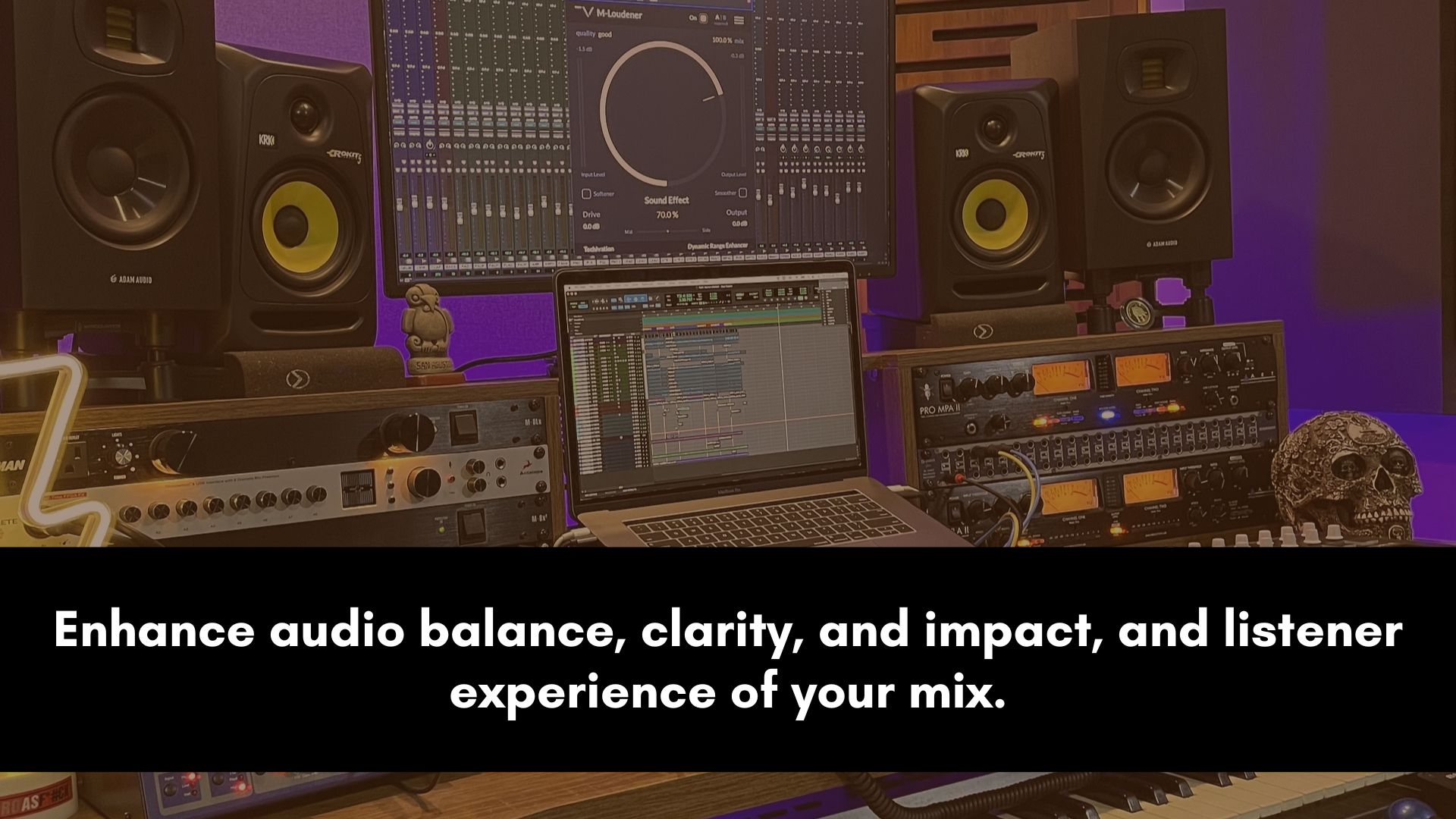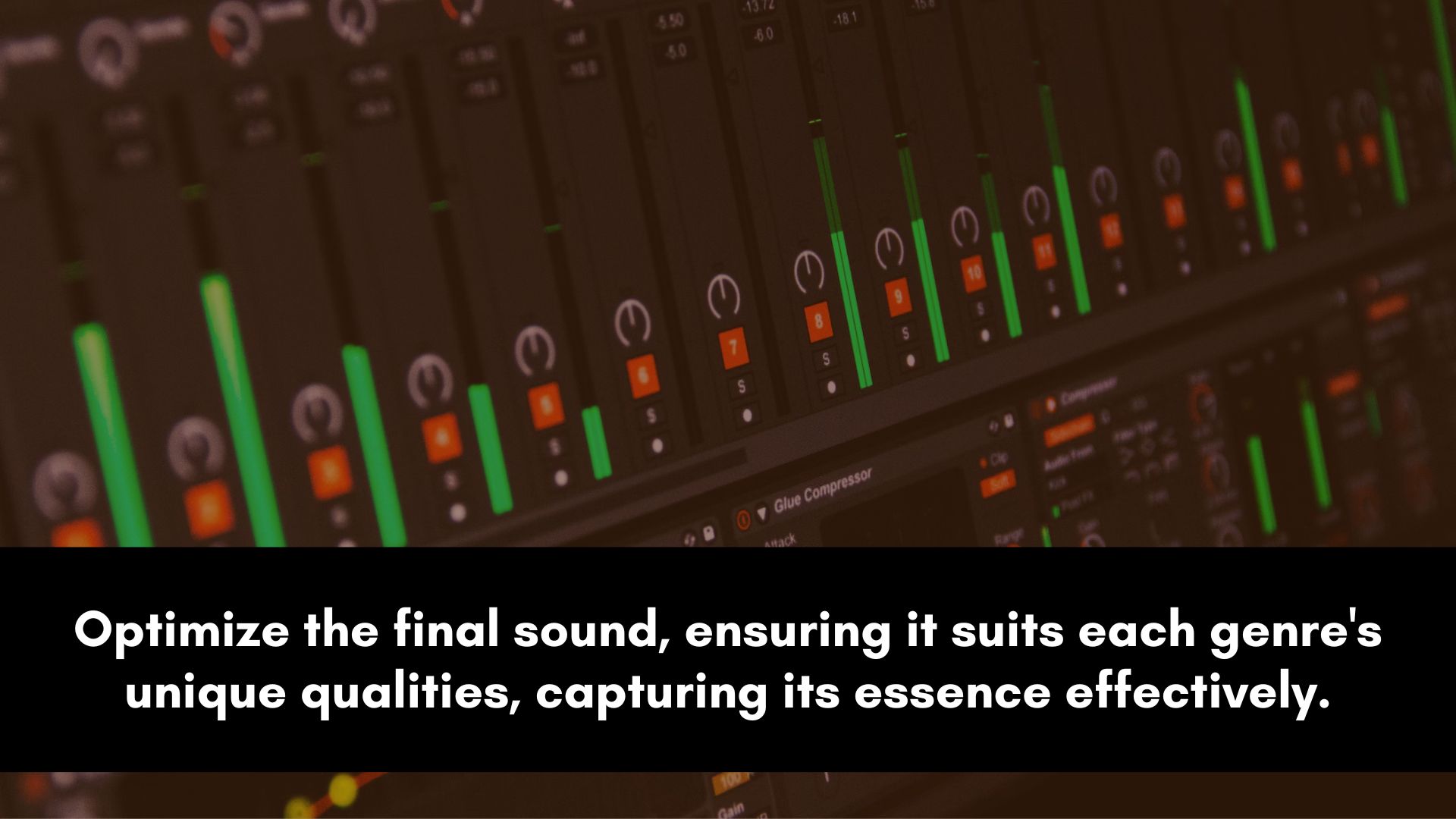It's time to supercharge your mixes.
If you've ever wondered how top-notch engineers achieve that polished and professional sound, you're about to discover the secrets.
In this guide, we'll unravel the mysteries of mix bus processing
You'll get the tools, knowledge, and techniques needed to transform your mixes into sonic masterpieces.
Get ready to unlock your full audio potential.
Mix Bus Processing Techniques

Getting your mix bus processing right is critical for a professional sound.
When done correctly, it enhances the overall balance, clarity, and cohesion of your mix.
Without proper processing, your mix may lack punch, warmth, and the ability to compete with other professional tracks, ultimately impacting the listener's experience.
In the next section, we’ll dive into how to apply compression to your mix bus channel.
A. Compression
To use mix bus compression effectively, start with a low ratio, like 2:1, and a medium to slow attack time (usually 10-100 ms).
This way, it won't squeeze your music too much.
Adjust the threshold until you see the compressor working gently. Be careful not to let the bus compressor squash your sound.
Play with the release time to find what feels right for your music. Faster releases add punch, while slower releases smooth things out.
Finally, use makeup gain to bring the overall volume back to where it was before compression.
Keep an eye on the gain reduction meter; aim for around 3-4 dB of compression.
B. Enhancing with EQ
For the mix bus EQ settings, begin by meticulously sweeping through your EQ bands.
Gently boosting or reduce different frequencies to pinpoint areas that require attention.
If you perceive muddiness, consider a subtle cut in the lower midrange (around 200-400 Hz).
For added brightness, experiment with a gentle boost in the high frequencies (approximately 5-10 kHz).
A slight boost in the low frequencies (around 100 Hz) can infuse warmth, if necessary.
Always remain attentive to how your EQ adjustments affect the entire mix, making fine-tuned changes for optimal results.
C. Adding Character with Saturation
Saturation introduces depth and character to your mix.
Commence with a subtle application of saturation, whether through a plugin or hardware option.
Experiment with various saturation choices (tube, tape, or transistor) to discover the flavor that complements your mix.
Pay close attention to how saturation impacts the overall mix balance, as even a small amount can produce significant results.
D. Limiting and Clipping
Achieving the right loudness level for your mix is crucial. Utilize limiting and clipping as to get your mixes louder.
Adjust your limiter's threshold to capture excessive peaks without compromising your mix's dynamics.
Setting the output ceiling just below -1 dB is vital to prevent digital clipping.
Be cautious not to overdo the limiting, as excessive gain reduction can drain the life from your music.
A modest reduction in gain is typically sufficient to manage peaks effectively.
This is usually left to the mastering engineer so it's better to communicate with them to find out what they prefer.
Some engineers don't mind limiters and clippers while others prefer a clean mix with no limiter.
Common Mix Bus Processing Mistakes
Even the most experienced sound engineers can stumble into common pitfalls that hinder rather than enhance their mixes.
In this section, we uncover common mistakes, guiding you through practical solutions to ensure your mixes achieve the clarity and brilliance they deserve.
Let's dive into the world of mix bus processing and learn how to avoid these critical errors.
- Over-Compression: Applying excessive compression can squash the life out of your mix, leading to a flat and dull sound. Avoid aggressive ratios and overly fast attack/release times.
- Over-EQing: Overloading your mix bus with EQ adjustments can result in unnatural tonal changes. Be subtle with your EQ moves, and always consider the mix as a whole.
- Neglecting Gain Staging: Failing to manage the gain structure throughout your mix can lead to clipping and distortion. Pay attention to levels at each stage of your signal chain.
- Inadequate Monitoring: Relying on subpar speakers or headphones can mislead your mix decisions. Invest in quality monitoring equipment to make accurate judgments.
- Over-Limiting: Overzealous limiting can cause audible artifacts and a loss of dynamics. Set your limiter thresholds judiciously and avoid excessive gain reduction.
- Neglecting Headroom: Filling the mix bus with plugins without leaving headroom can lead to clipping and distortion. Leave some headroom to prevent digital distortion.
- Misusing Saturation: Using saturation excessively or inappropriately can muddy your mix. Apply it subtly and consider the genre and style of music you're working on.
- Blindly Copying Settings: Applying mix bus processing settings from one track to another without considering the unique characteristics of each mix can lead to poor results. Tailor your mix bus processing to each project.
- Lack of A/B Testing: Failing to compare your mix with and without processing can lead to poor decision-making. Always A/B test to ensure your processing enhances the mix.
- Neglecting Your Ears: Relying solely on meters and visuals without using your ears can result in misguided mix bus decisions. Trust your ears as the ultimate judge of your mix.
Mix Bus Processing for Different Genres

Mix bus processing isn't a one-size-fits-all approach.
Different music genres have distinct characteristics, and your mixing techniques should align with these unique qualities.
Rock & Metal
For genres like rock and metal, punchy and dynamic mixes are key.
Use mix bus compression to even out the levels and make the instruments hit hard.
Gentle EQ adjustments can emphasize the guitar's crunch or the punch of the kick drum.
Be cautious with saturation, as these genres often benefit from a cleaner, more transparent sound.
Pop & Hip-Hop
Pop and hip-hop tracks often demand a polished, radio-ready sound.
Aggressive mix bus compression can help achieve a consistent, loud mix.
Consider EQ boosts in the upper frequencies to make vocals and instruments shine.
Saturation can add warmth and character to pop tracks but should be used sparingly.
Electronic Music
For electronic and EDM genres, clarity and energy are crucial.
Limiting can help control peaks, allowing for a more controlled and powerful sound.
Use EQ to highlight the punchy bass and sparkling highs.
Saturation and harmonic enhancement can add texture and depth to synths and electronic elements.
Acoustic Genres
Classical and acoustic music require a delicate touch.
Minimal mix bus processing is often preferred to maintain the purity of acoustic instruments.
A light touch of EQ can help balance the frequencies, and subtle compression can control dynamics without sacrificing the natural feel.
Jazz & Blues
In jazz and blues, preserving the organic, live sound is vital.
Use compression sparingly to retain the dynamics of instruments like saxophones and pianos.
Gentle EQ adjustments can bring out the warmth of double bass or the crispness of a jazz drum kit.
Reggae & World Music
In reggae and world music, groove and space are essential.
Light compression on the mix bus can help glue the elements together.
Use EQ to accentuate the unique timbres of ethnic instruments and vocals.
Saturation can add warmth and a vintage feel.
Country Music
Country music often relies on the authenticity of acoustic instruments.
Minimal mix bus processing is suitable, with slight EQ tweaks to enhance vocals and guitars.
Saturation can add a touch of warmth to the mix without overwhelming its natural essence.
In summary, adapting your mix bus processing to suit the genre is vital for achieving the desired sonic characteristics.
Always keep the genre's unique qualities in mind.
Tips for Achieving Clarity
In the realm of mix bus processing, clarity is the golden ticket to a captivating audio mix.
Discover these essential tips to ensure your mixes shine with remarkable clarity and precision.
- Start with a Clean Mix: Ensure that your individual tracks are well-balanced and free from unnecessary clutter before applying mix bus processing.
- Control Low Frequencies: Pay special attention to the low end, as excessive bass can muddy the mix. Use high-pass filters and EQ to keep it in check.
- Prioritize Balance: Focus on the balance between instruments and vocals. Ensure that no element overpowers the others.
- Reference Tracks: Compare your mix to professionally mastered tracks in the same genre to gauge its clarity and overall quality.
- Practice and Experiment: Developing your processing skills takes time. Don't be afraid to experiment and refine your techniques over multiple projects.
By implementing these tips, you can enhance the clarity of your mixes, ensuring that every element shines through and delivers a clear and polished listening experience.
FAQ:
What is a mix bus?
A mix bus is like a control center for all the sounds in a music or audio project.
It's where you bring together all the different parts, like vocals, instruments, and drums, to make them sound great together.
You can use special tools on the mix bus to adjust the overall sound and balance.
It's an important part of making sure the final mix sounds clear, balanced, and polished before people get to hear it.
What's the difference between mix bus and master bus?
The mix bus and master bus are both parts of the audio production process but serve different purposes.
The mix bus is where you shape the individual tracks in your mix, adjusting their balance and sound.
The master bus, on the other hand, is the final stage, where you prepare the entire mix for distribution.
It involves subtle enhancements like final EQ, compression, and limiting to ensure the mix sounds good on all devices.